ABOUT US
 My son Dean invited me to join him on a business trip. For a mom to have an
opportunity to have quality time with an adult son - it doesn't get much better than that!
My son Dean invited me to join him on a business trip. For a mom to have an
opportunity to have quality time with an adult son - it doesn't get much better than that!
Our first stop was Singapore. What a delightful place. 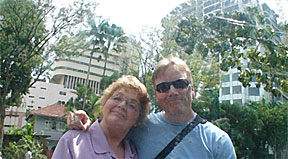 Everything was clean. You get a fine if you throw trash in the streets. If you hit a tree with your
car, you plant another one. And there was no crime. When
Everything was clean. You get a fine if you throw trash in the streets. If you hit a tree with your
car, you plant another one. And there was no crime. When  we got off the plane in Singapore, we were
handed the notice to the left. I think they’re on to something!
we got off the plane in Singapore, we were
handed the notice to the left. I think they’re on to something!
Deans business took him to Bangalore, India. I had a desire to connect with people who were helping the poor. So after work, Dean and I went to the heart of the city. Next to relatively nice homes,  we came to unbelievable slums where we heard and saw for the first time what life is like for the untouchables (Dalits) of India.
we came to unbelievable slums where we heard and saw for the first time what life is like for the untouchables (Dalits) of India.
They are unable to access adequate education, and because of the social stigma of "untouchability", society forces them to take low-paying jobs that provide inadequate income. They cannot afford basic food, clothing, shelter, medical care or education needs. There are approximately 1,000 remote villages and city slums in India where 300 million untouchables live - read more
Right in the middle of these slums, we came to a very basic school building. We were greeted by children who were clean, happy and had incredible hope in their eyes. 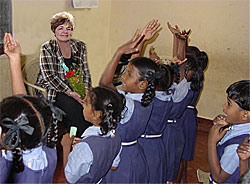 They presented us with flowers and sang for us. It brought tears to my eyes. This school is providing Dalit children in these slums a quality, English education built on high academic standards and a world view based on human dignity and self-worth. It was built by people like us who care.
They presented us with flowers and sang for us. It brought tears to my eyes. This school is providing Dalit children in these slums a quality, English education built on high academic standards and a world view based on human dignity and self-worth. It was built by people like us who care.
All around this school was squalor and poverty. I asked if I might visit some of these families in their shacks. I was told that they would be honored that I would want to. As I started walking, two of the children ran ahead of me and shouted, the English woman is coming, the English woman is coming.
We went back to the states and started working on a plan that would enable children in economically challenged areas of the world to have access to education built on high academic standards and a world view based on human dignity and self-worth. Five years of work resulted in the Just Let Me Learn Foundation. - read more
THE DALITS

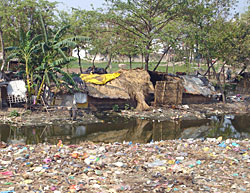 The Dalit people of India have been the most widely oppressed caste for more than three thousand years. Indian Dalit's comprise nearly 1/4 of the total population, a massive 250 million men, women, and children. Dalit's are considered the "outcasts" of Indian society - the "untouchables", those the Hindu scriptures call the "unborn" - translated: it would be better if they had never been born.
The Dalit people of India have been the most widely oppressed caste for more than three thousand years. Indian Dalit's comprise nearly 1/4 of the total population, a massive 250 million men, women, and children. Dalit's are considered the "outcasts" of Indian society - the "untouchables", those the Hindu scriptures call the "unborn" - translated: it would be better if they had never been born.
The caste system has been in place for more than 3,000 years and was created for the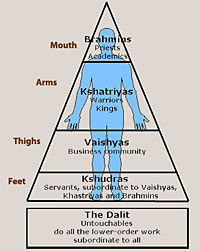 division of labour among the community. At the top of the caste system are the Brahmins, who are the priests and arbiters of what is right and wrong in matters of religion and society. Next come the Kshatriyas, who are soldiers and administrators. The Vaisyas are the artisan and commercial class, and finally, the Sudras who are the farmers and the peasant class. These four castes are said to have come from Brahma's mouth (Brahmin), arms (Kshatriyas), thighs (Vaisyas) and feet (Sudras).
Beneath the four main castes is a fifth group, the Scheduled Caste. They literally have no caste. They are the untouchables, the Dalit's, which means "crushed", "downtrodden", "broken".
division of labour among the community. At the top of the caste system are the Brahmins, who are the priests and arbiters of what is right and wrong in matters of religion and society. Next come the Kshatriyas, who are soldiers and administrators. The Vaisyas are the artisan and commercial class, and finally, the Sudras who are the farmers and the peasant class. These four castes are said to have come from Brahma's mouth (Brahmin), arms (Kshatriyas), thighs (Vaisyas) and feet (Sudras).
Beneath the four main castes is a fifth group, the Scheduled Caste. They literally have no caste. They are the untouchables, the Dalit's, which means "crushed", "downtrodden", "broken".
Dalit's are denied access to public wells, public parks, basic medical services, and education. Many places even have clay cups for drinking reserved only for Dalit's. The clay cups are broken and thrown away after they are used. The ruling caste tells them they are Hindu, yet they are denied access to the temples, cannot become temple 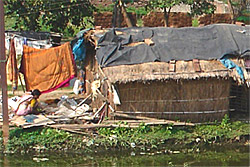 priests, and are even prohibited from reading the Hindu scriptures. Seventy percent of Dalit's live below the poverty line. Only 10% of Dalit women can read and write, and are often sold into bonded prostitution.
priests, and are even prohibited from reading the Hindu scriptures. Seventy percent of Dalit's live below the poverty line. Only 10% of Dalit women can read and write, and are often sold into bonded prostitution.
The caste system is an integral part of Indian society dating back to the time of the Aryan invaders to India. The Hindu religion sanctioned the caste system. Dalit's across the nation, however, have experienced an awakening and are seeking ways to educate their children as keys to finding liberation.
THE ORPHANAGE
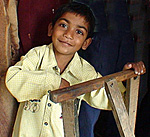 While in Siwan we visited an orphanage and met a boy named Manish. He lived in the orphanage with his two brothers. Manish was 6 years old, crippled and must walk with a makeshift walker built by the orphanage. It was really the only way he
could get around without crawling. The amazing part of this story was that he and his brothers were still alive.
While in Siwan we visited an orphanage and met a boy named Manish. He lived in the orphanage with his two brothers. Manish was 6 years old, crippled and must walk with a makeshift walker built by the orphanage. It was really the only way he
could get around without crawling. The amazing part of this story was that he and his brothers were still alive.
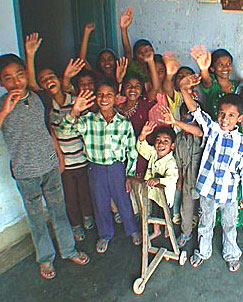 Three years earlier, the orphanage found Manish and his two brothers begging in the streets.
The father was in prison and the mother had committed suicide. They had no money, food or place
to live. Manish was three years old and crawling in the street.
Three years earlier, the orphanage found Manish and his two brothers begging in the streets.
The father was in prison and the mother had committed suicide. They had no money, food or place
to live. Manish was three years old and crawling in the street.
TRAFFIC IN INDIA
Our first destination in India was Bangalore. The first WHITE KNUCKLE ride from the airport to the hotel about did me in. I didn't see any traffic lights. The traffic just goes whereever they can squeeze in.
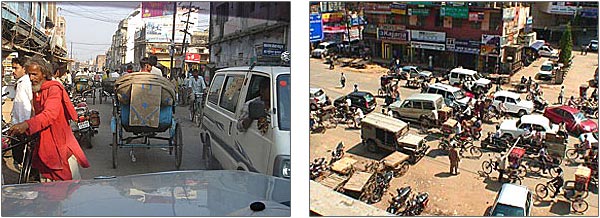
 After a few days, I began to realize there IS a rhythm that controls traffic. For those who are fortunate enough to have a vehicle, THEY USE THEIR HORNS TO MAKE TRAFFIC WORK . . . AND THEIR HORNS ARE BLARING ALL THE TIME!
And guess who has the right of way . . . THE ANIMALS. Surprisingly I only saw one accident the entire time we were in India.
After a few days, I began to realize there IS a rhythm that controls traffic. For those who are fortunate enough to have a vehicle, THEY USE THEIR HORNS TO MAKE TRAFFIC WORK . . . AND THEIR HORNS ARE BLARING ALL THE TIME!
And guess who has the right of way . . . THE ANIMALS. Surprisingly I only saw one accident the entire time we were in India.
We also visited Patna, Bihar and then travelled by jeep to the town of Siwan. It was a four hour trip one way. I think it was that road that originated the term “POT HOLES”. The entire 4 hours, we were bouncing and holding on for dear life. I also think the driver of our jeep had a death wish as he drove as fast as he could weaving in and out of anything that got in his way.
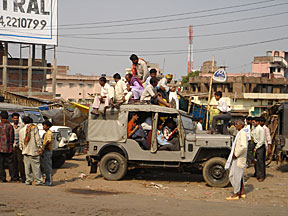 The jeep you see in the picture on the right also traveled this same route. In India, any form of transportation packs as many people in as possible - up on top - hanging from the sides and jammed into the inside. Nearly 19 people were in this jeep. The drivers don’t leave until they have filled every space. How they made that 4 hour trip without losing anyone is beyond me.
The jeep you see in the picture on the right also traveled this same route. In India, any form of transportation packs as many people in as possible - up on top - hanging from the sides and jammed into the inside. Nearly 19 people were in this jeep. The drivers don’t leave until they have filled every space. How they made that 4 hour trip without losing anyone is beyond me.
![]()
